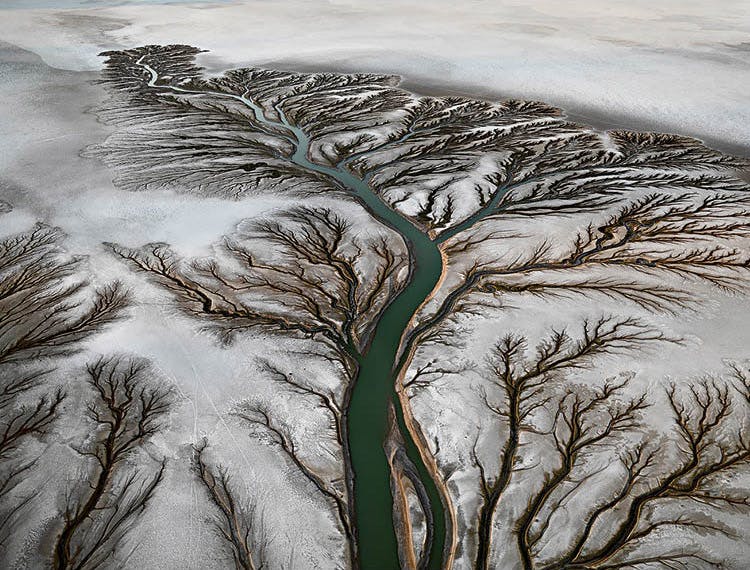
- Magazine Article
- Exhibitions
Water Quality
Edward Burtnysky's monumental photographs immerse the viewer

Colorado River Delta #2, Near San Felipe, Baja, Mexico, 2011. Edward Burtynsky (Canadian, b. 1955). Digital chromogenic print on paper; 121.9 x 162.6 cm. New Orleans Museum of Art, Gift of the artist, 2016.46.19. © Edward Burtynsky, courtesy Weinstein-Hammons Gallery, Minneapolis / Metivier Gallery, Toronto
Art addresses a momentous social and ecological issue in Edward Burtynsky’s series Water: humanity’s increasingly stressed relationship with that vital natural resource. His photographs, which take us from the California desert to the shores of the Ganges River, demonstrate that water management is a global concern. The issue also has resounding local relevance. This summer Cleveland launches a yearlong commemoration of the 50th anniversary of the last Cuyahoga River fire and celebrates subsequent progress made toward cleaner water.
Burtynsky spent five years exploring the mechanisms employed by humankind to redirect and control water. Portraying the enormous scale of those systems required aerial perspective, so he shot from construction lifts, small fixed-wing aircraft, helicopters, drones, and a specially designed 50-foot pneumatic mast topped by a remotely operated camera. The resulting images emphasize the visual as well as the ecological impact humans have on the earth.
The dark calligraphy of an oil slick in the vivid blue-green Gulf of Mexico draws our attention to a compromised ocean. The eccentrically shaped plots of dryland farming, colored rust, brown, and dark green, in Aragon, Spain, signal a resourceful use of water and land. Their irregular patterning forms a stark contrast with the perfect circles of pivot irrigation in the arid Texas Panhandle, where the water source is the rapidly depleting Ogallala Aquifer. Since 70 percent of fresh water under human control is directed toward agriculture, it is crucial that irrigation methods be as efficient as possible. Aquaculture—farmed seafood—is an increasingly important food source. Combining agriculture and aquaculture, cascading layers of sinuously terraced rice paddies gently descend hills in China, forming elegant wave-like patterns. During the wet season, the paddies are used to raise fish.
The branching design of browns and whites in Colorado River Delta #2, Near San Felipe, Baja, Mexico (2011) indicates a landscape in distress. According to the artist, the delta “has not seen a drop of water from that river in over 40 years and is now a desert.” The image documents channels created in the Colorado River delta by tides that pull sediment to the ocean. Without sediment deposits from upriver, the land will eventually sink into the Gulf of California. An early 1920s compact divided the river’s water between seven American states and allotted only 10 percent to Mexico. Subsequent arrangements further reduced the flow and dried up these once vital wetlands. A new five-year agreement hopes to offer a recharge of fresh water and a reduction in salinity. However, the clout of California farmers concerned about diverting more water to Mexico makes extension of the current pact uncertain.

Not too far from the delta’s sere landscape is the lush blue lake seen in Cerro Prieto Geothermal Power Station, Baja, Mexico (2012). One of the world’s largest geothermal plants, the station pumps volcanically heated water from hundreds of meters underground and dumps it into Lake Cerro Prieto, a tourist attraction and popular recreational destination. As the steam evaporates, the lithium and potassium salts in it are concentrated, turning parts of the lake a startling aquamarine color while also creating a potentially hazardous impact on human health.
These and other hauntingly beautiful landscapes by Burtynsky echo moments in 20th-century painting, including abstraction. A masterful formalist, the photographer has recognized in this series the influence of some of his favorite painters, including Caspar David Friedrich, Jean Dubuffet, David Shapiro, and Richard Diebenkorn. The monumental scale of Burtynsky’s prints amplifies their relationship to painting and immerses viewers into the scene. In the museum’s somewhat unusual installation, detailed information on the individual sites is provided in a free gallery guide rather than on wall labels. This encourages visitors to experience these works as symphonies of form, color, and rhythm before analyzing their environmental messages.
The artist’s photographs of dams, dikes, terraces, aquaculture sites, and irrigation systems suggest that humans know how to control water. The desiccated river delta, dried-up lakes, and polluted oceans advise otherwise. Burtynsky acknowledges the ambiguities and complexities of water management but leaves it to viewers to decide whether the current strategies are among humankind’s great achievements or its most dangerous failures.

Cleveland Art, May/June 2019